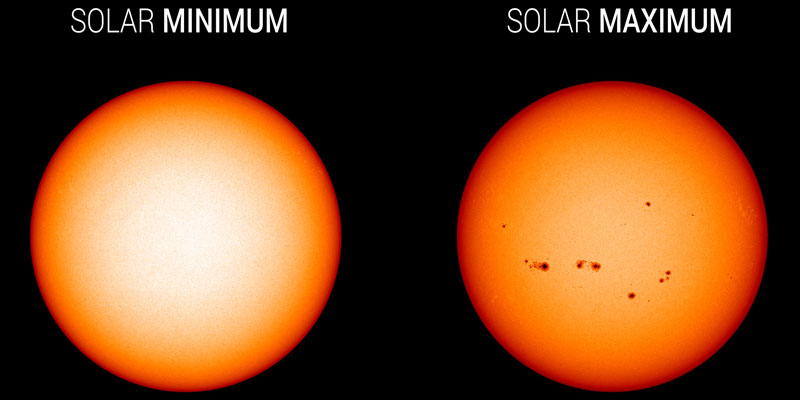- World
- Sep 19
Solar Cycle 25 has begun, say experts
American space agency NASA and the National Oceanic and Atmospheric Administration (NOAA) announced that the Sun has entered a new solar cycle, officially known as Solar Cycle 25.
Experts from the National Aeronautics and Space Administration (NASA) and the NOAA discussed their analysis and predictions about the new solar cycle, and how the coming upswing in space weather will impact our lives and technology on Earth, as well as astronauts in space.
The Solar Cycle 25 Prediction Panel, an international group of experts co-sponsored by NASA and NOAA, announced that the solar minimum occurred in December 2019, marking the start of a new solar cycle.
What is solar cycle?
The Sun is a huge ball of electrically-charged hot gas. This charged gas moves, generating a powerful magnetic field. The Sun’s magnetic field goes through a cycle, called the solar cycle.
Every 11 years or so, the Sun’s magnetic field completely flips. This means that the Sun’s north and south poles switch places. Then it takes about another 11 years for the Sun’s north and south poles to flip back again.
The solar cycle affects activity on the surface of the Sun, such as sunspots which are caused by the Sun’s magnetic fields. As the magnetic fields change, so does the amount of activity on the Sun’s surface.
How researchers track the solar cycle?
One way to track the solar cycle is by counting the number of sunspots. The beginning of a solar cycle is a solar minimum, or when the Sun has the least sunspots. Over time, solar activity and the number of sunspots increases.
The middle of the solar cycle is the solar maximum, or when the Sun has the most sunspots. As the cycle ends, it fades back to the solar minimum and then a new cycle begins.
Some cycles have maximums with lots of sunspots and activity. Other cycles can have very few sunspots and little activity. Scientists work hard to improve our ability to predict the strength and duration of solar cycles. These predictions can help them forecast these solar conditions, called space weather.
How do these changes affect the Earth?
Giant eruptions on the Sun, such as solar flares and coronal mass ejections, also increase during the solar cycle. These eruptions send powerful bursts of energy and material into space.
This activity can have effects on Earth. For example, eruptions can cause lights in the sky, called aurora, or impact radio communications. Extreme eruptions can even affect electricity grids on Earth.
Forecasting of the solar cycle can help scientists protect our radio communications on Earth.
Solar activity can affect satellite electronics and limit their lifetime. Radiation can be dangerous for astronauts. If scientists predict an active time in the solar cycle, satellites can be put into safe mode and astronauts can delay their spacewalks.
Scientists expect the Sun’s activity to ramp up toward the next predicted maximum in July 2025.
Features of Solar Cycle 24
Solar Cycle 24 was average in length, at 11 years, and had the fourth-smallest intensity since regular record keeping began with Solar Cycle 1 in 1755. It was also the weakest cycle in 100 years. Solar maximum occurred in April 2014 with sunspots peaking at 114 for the solar cycle, well below average, which is 179.
Solar Cycle 24’s progression was unusual. The Sun’s northern hemisphere led the sunspot cycle, peaking over two years ahead of the southern hemisphere sunspot peak. This resulted in solar maximum having fewer sunspots than if the two hemispheres were in phase.
The solar minimum between Solar Cycle 24 and 25 happened in December 2019, when the 13-month smoothed sunspot number fell to 1.8, according to the Solar Cycle 25 Prediction Panel.
Predictions on Solar Cycle 25
If Solar Cycle 25 meets the panel’s predictions, it should be weaker than average. Cycle 25 is also expected to end a longer trend over the past four decades, in which the magnetic field at the Sun’s poles were gradually weakening. As a result, the solar cycles have been steadily weaker too.
If Solar Cycle 25 sees an end to this waning, it would quell speculations that the Sun might enter a grand solar minimum, a decades-to-centuries long stretch of little solar activity. The last such minimum — known as the Maunder minimum — occurred in the middle of what’s known as the Little Ice Age from the 13th to 19th centuries, causing erroneous beliefs that another grand minimum could lead to global cooling.
Solar Cycle Prediction Panel
Since 1989, the Solar Cycle Prediction Panel — an international panel of experts sponsored by NASA and NOAA — has met each decade to make their prediction for the next solar cycle. The prediction includes the sunspot number at maximum and the cycle’s expected start and peak. The effort requires assessing many different models.
There are many approaches to modeling the Sun in order to develop solar cycle predictions. Some models use ground-based observations spanning hundreds of years. Others may use satellite data, which has only been available for the past four decades or so. In recent years, some researchers have incorporated machine-learning tactics.
It’s the job of the Solar Cycle Prediction Panel to evaluate all of these models and release an official prediction representing the scientific community’s best efforts.
Manorama Yearbook app is now available on Google Play Store and iOS App Store


